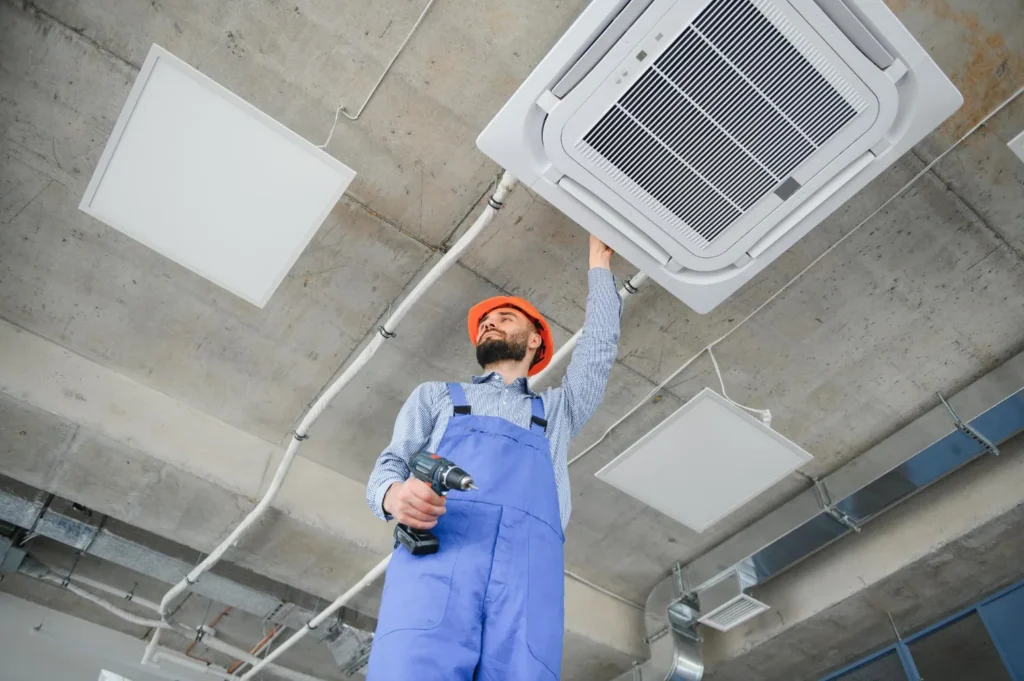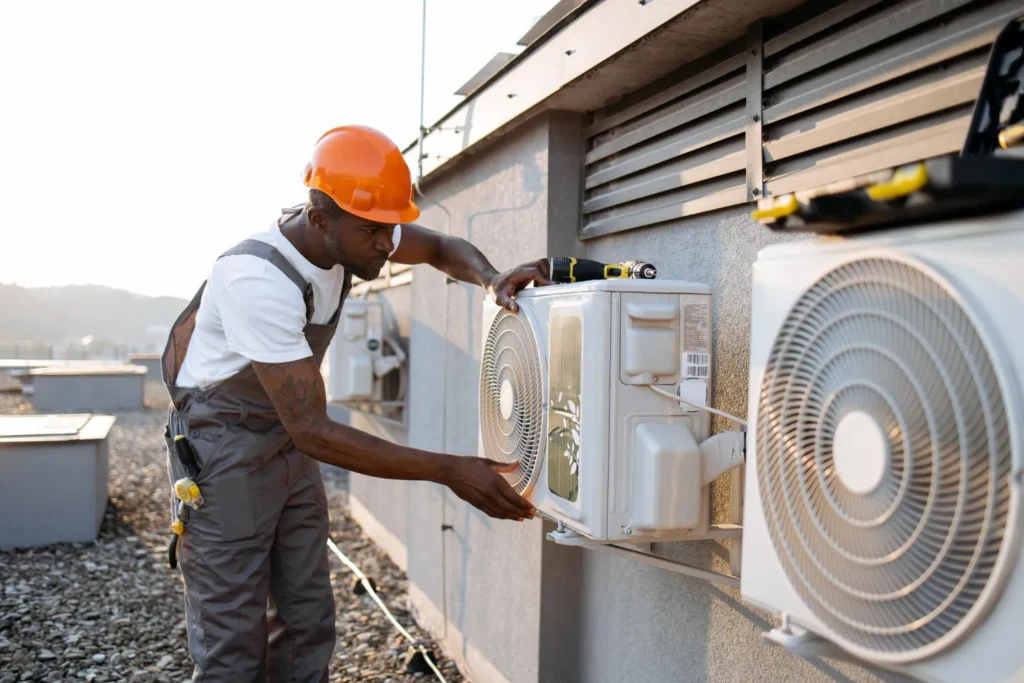A reliable air conditioning system is not merely a comfort but a necessity. Yet, the effectiveness of an AC installation transcends the mere cooling of air; it fundamentally hinges on the quality of proper ventilation for AC installation integrated into the system. As an AC installer with extensive experience, We have consistently observed that adequate vents is crucial for maximizing both the efficiency and the health benefits of air conditioning systems. This article delves deep into the significance of ventilation in AC systems, exploring how it impacts everything from energy efficiency to indoor air quality (IAQ), particularly in challenging climates like that of Richmond.
Adequate ventilation ensures that the air conditioner does not recycle pollutants back into the indoor environment, thus maintaining a cleaner and healthier air supply. Furthermore, by optimizing airflow, proper ventilation helps prevent the buildup of humidity and condensation, which are common problems that can lead to mold growth and structural damage over time. This exploration will not only highlight the technical aspects of ventilation but also provide practical insights and recommendations for ensuring optimal airflow in residential and commercial settings.
Why Ventilation Matters in AC Installations

Understanding the role of ventilation in air conditioning systems is crucial for ensuring efficient operation and maintaining indoor air quality.
Fresh Air Intake Is Essential
One of the core functions of any sophisticated air conditioning system, be it a central air conditioner or a mini-split system, is not just to recirculate air but to ensure a consistent introduction of fresh air from outside. Fresh air intake is critical in this process, as it directly combats the stagnation of indoor air, diluting accumulated pollutants and injecting a stream of fresh outdoor air into the indoor environment.
Where external temperatures and humidity levels soar, the ability of an AC system to pull in fresh air is indispensable. This feature helps maintain an optimal balance of indoor air pressure, which is crucial for preventing negative pressure scenarios. Negative pressure can inadvertently draw in unfiltered, humid air through structural leaks, undermining both the air quality and the energy efficiency of the system. By integrating a fresh air intake, AC systems not only enhance comfort levels but also significantly improve air quality by reducing indoor pollutants like VOCs, allergens, and pathogens.
The Role of Exhaust Fans
Exhaust fan are integral to effective ventilation strategies in air conditioning installations. They are exceptionally vital in high-humidity areas like Richmond, TX, where removing excess moisture from indoor spaces is essential to prevent mold growth and condensation issues. These fans help by actively expelling stale air and excess humidity from indoor spaces to the outside, which assists in maintaining a dry and relaxed environment.
The strategic placement and operation of exhaust fans can dramatically enhance the ventilation effectiveness of both residential and commercial AC systems. In commercial settings, where the buildup of odors and chemicals can be more pronounced due to more significant occupant numbers or specific industrial activities, exhaust fans play a crucial role in maintaining a safe and pleasant indoor atmosphere. They ensure that air circulates properly, preventing the formation of air pockets where stale air or pollutants might accumulate.
Strategic Ductwork Design
Effective ductwork design is essential for optimizing the ventilation in any air conditioning installation. Properly designed and installed ductwork ensures that cool air is efficiently distributed throughout the space while facilitating the return of indoor air back to the AC system for reconditioning. In Richmond, where differences in indoor and outdoor temperatures are significant, well-planned ductwork is crucial for minimizing energy losses and enhancing the overall system performance.
In the context of ductwork design, considerations such as the size, layout, and insulation of ducts play a pivotal role. Oversized or leaky ductwork can lead to significant energy inefficiencies, as cool air may be lost before it effectively reaches its intended destination within a building. Furthermore, ducts need to be adequately sealed and insulated, particularly in unconditioned spaces such as attics or crawl spaces, to prevent condensation and maintain the integrity of the air being transported.
Problems with Improper Ventilation in AC Systems
Improper ventilation in AC systems can lead to a host of issues, including reduced efficiency, increased energy consumption, and poor air quality.
Stagnant Air and Pollutant Buildup
One of the most significant issues arising from inadequate ventilation in air conditioning systems is the accumulation of stagnant air and pollutants. In environments like Richmond, TX, where external temperatures can be extreme, AC systems are often heavily relied upon, running almost continuously. Without proper ventilation, air does not circulate effectively, leading to the buildup of indoor pollutants such as volatile organic compounds (VOCs), dust mites, and other allergens. This can create an unhealthy indoor atmosphere and exacerbate respiratory problems among occupants.
Condensation and Moisture Issues
Improper ventilation can lead to excessive humidity inside buildings. This not only makes the indoor environment uncomfortable but also contributes to the growth of mold and mildew, which can degrade building materials and adversely affect health. In AC systems, particularly in humid climates like Richmond’s, the lack of adequate exhaust fans and poorly designed ductwork can prevent moisture-laden air from being expelled effectively. This often results in condensation on windows, walls, and other surfaces, which, if left unchecked, can lead to structural damage and the need for costly repairs.
AC Inefficiency and Increased Energy Costs
When an AC system lacks proper ventilation, it must work harder to maintain the desired indoor climate. This inefficiency not only increases energy consumption but also leads to higher utility bills. Moreover, the additional strain on the AC unit’s compressor and other components accelerates wear and tear, potentially leading to more frequent breakdowns and replacements. For businesses and homeowners in Richmond, this can mean significant and unplanned financial outlays, which could have been mitigated by ensuring that the AC system was well ventilated from the outset.
Enhancing AC System Performance with Optimal Ventilation
Optimizing ventilation within your AC system not only improves air quality but also enhances overall system performance and durability.
Importance of Air Exchange Rates
A key component in maintaining efficient AC performance is the air exchange rate, which refers to the number of times the air within a room is replaced with fresh air in a given period. This rate is crucial for diluting indoor air pollutants and providing comfortable living and working conditions. By optimizing the air exchange rate through adequate ventilation in AC systems, buildings in Richmond can achieve better air quality while maintaining efficient energy use.
Integration of Fresh Air Intake Systems
To combat the issues of stagnant air and pollutant buildup, integrating fresh air intake systems into the AC installation is essential. These systems work by bringing in a controlled amount of outdoor air, which can be conditioned and circulated throughout the building. This not only helps in maintaining a healthy balance of indoor and outdoor air but also assists in pressure regulation, preventing the infiltration of unconditioned air through leaks or other openings in the building envelope.
The Role of HVAC Maintenance
Regular HVAC maintenance is critical to ensuring that ventilation components function as intended. This includes checking and cleaning air filters, inspecting ductwork for leaks, and ensuring that exhaust fans and fresh air intakes are clear of obstructions and operating efficiently. For establishments and residences in Richmond, where AC systems are a critical part of daily comfort, ongoing maintenance is a small but crucial investment in extending the life of the system and ensuring it runs efficiently.
In conclusion, proper ventilation is not merely an additional feature of an air conditioning system but a fundamental aspect that determines its efficiency, effectiveness, and the health of its users. By understanding and implementing robust ventilation strategies, homeowners and businesses in Richmond, TX, can enjoy the full benefits of their investments in air conditioning technology, ensuring comfort and safety in the extreme Texan heat.
Leveraging Advanced Technologies for Improved Ventilation

Advanced ventilation technologies offer new ways to enhance airflow and filtration, contributing to more effective and efficient air conditioning systems.
Utilizing Energy Recovery Ventilators (ERV)
In the quest for optimal ventilation within air conditioning systems, Energy Recovery Ventilators (ERV) emerge as a pivotal technology, especially in climates like Richmond, TX, where both cooling and humidity control are crucial. ERVs work by exchanging the energy contained in typically exhausted building or space air and using it to treat the incoming outdoor ventilation air in residential and commercial HVAC systems. This process not only conserves energy but also enhances indoor air quality by maintaining balanced humidity levels, which are critical for comfort and health.
Benefits of Variable Refrigerant Flow (VRF) Systems
Variable Refrigerant Flow (VRF) systems represent another advanced solution that enhances ventilation and overall system efficiency. These systems are designed to provide precise cooling and heating to multiple areas within a building, each with its own control. VRF technology supports efficient air exchange rates and improves indoor air quality (IAQ) by offering consistent and accurate temperature control. It reduces the chances of overcooling or overheating, which can lead to humidity problems and inefficient system operation.
Addressing Challenges in Ventilation for Specific Settings
Tailoring ventilation strategies to meet the unique demands of different environments ensures that AC systems perform optimally in any setting.
Residential AC Systems
In residential settings, ensuring adequate ventilation often means balancing the need for comfort with energy efficiency. For homeowners in Richmond, it is crucial to choose AC systems that complement the building’s structure while ensuring efficient air exchange rates. Solutions like ductless mini-splits or multi-zone VRF systems can offer significant advantages in terms of both performance and energy usage, providing precise cooling without extensive ductwork and the associated air quality issues.
Commercial AC Systems
Commercial buildings, with their varying sizes and usage patterns, require a more tailored approach to ventilation. In these environments, systems like central air conditioning with integrated fresh air intake and ERV technology can be highly effective. These setups ensure that large spaces can maintain air quality without sacrificing energy efficiency. The integration of automated building management systems can further enhance this by dynamically adjusting airflows based on the occupancy and current air quality readings, ensuring optimal conditions across different zones of the building.
Adhering to Building Codes and Standards for Ventilation
Compliance with building codes and standards is essential for legal and safety reasons. It ensures that ventilation systems are correctly installed and functioning.
Importance of HVAC Permit Requirements
Adhering to local HVAC permit requirements is crucial in ensuring that ventilation systems are up to standard and operate safely. In Richmond, TX, these permits are not just bureaucratic formalities but safeguards that ensure HVAC systems meet stringent safety and efficiency standards. They require systems to be inspected and approved, which helps in preempting potential issues related to poor ventilation that could affect health and safety.
Ensuring Compliance with IAQ Standards
Indoor air quality standards are becoming increasingly stringent as awareness of the health impacts of poor air quality grows. Complying with these standards is not only a legal requirement but also a moral one for any AC installation, whether residential or commercial. It involves selecting equipment and designing systems that can effectively control pollutant levels, manage humidity, and ensure adequate ventilation.
In conclusion, the proper design and maintenance of ventilation in AC systems are critical components that require careful consideration and integration of advanced technologies and methodologies. For residents and businesses in Richmond, TX, understanding and implementing these concepts can lead to more efficient, health-friendly, and cost-effective air conditioning solutions. By investing in quality ventilation, the community can enjoy enhanced comfort and air quality, even in the face of Texas’ challenging climate conditions.
Future Trends in AC Ventilation in AC Installations

Emerging trends in AC ventilation technology are set to revolutionize how we manage indoor climate control, focusing on sustainability and energy efficiency.
The Rise of Smart HVAC Systems
As technology advances, so does the integration of intelligent systems into home and commercial ventilation. Innovative HVAC systems equipped with sensors and Internet of Things (IoT) connectivity are becoming increasingly popular in Richmond, TX. These systems optimize air conditioning performance by automatically adjusting settings based on real-time data such as air quality, humidity, and occupancy levels. This level of automation not only improves indoor air quality but also enhances energy efficiency by ensuring that the AC operates only when necessary and at optimal settings.
Emphasizing Sustainable and Eco-Friendly Solutions
Sustainability is becoming a key concern in HVAC design, especially in areas like Richmond that experience extreme weather. Future trends in AC ventilation include the adoption of eco-friendly technologies such as geothermal heating and cooling systems and solar-powered AC units. These systems significantly reduce the reliance on fossil fuels and decrease carbon emissions, aligning with global efforts to combat climate change while providing efficient cooling and heating.
Educating Clients on the Importance of Proper Ventilation
Informing clients about the importance of proper ventilation helps them understand their AC systems better and the benefits of maintaining good air quality.
Role of Service Professionals
As service professionals, it’s our responsibility to educate clients about the importance of proper ventilation in their air conditioning systems. This involves explaining how various components like ERV, fresh air intake, and adequate ductwork design contribute to a healthier, more comfortable environment. By providing clients with knowledge and understandable data, we can guide them in making informed decisions about their AC installations tailored to their specific needs in Richmond, TX.
Offering Customized Solutions
Each building and space has unique requirements based on its design, usage, and occupancy. Offering customized ventilation solutions allows for the adaptation of technology and methods to suit specific needs. For instance, residential homes may benefit significantly from ductless mini-split systems for targeted cooling without extensive ductwork. In contrast, larger commercial spaces might require robust central air conditioning systems with advanced air filtration and energy recovery ventilators.
Conclusion
Proper ventilation in AC installations is not just a technical requirement—it’s a vital aspect that significantly impacts the effectiveness and efficiency of the air conditioning system, especially in regions like Richmond, TX, where the climate demands a lot from cooling systems. The future of air conditioning lies in innovative, sustainable technologies that enhance indoor air quality and promote energy efficiency.
By understanding the detailed dynamics of ventilation, embracing advanced technologies, and adhering to stringent building codes, we can ensure that our air conditioning systems do more than just fantastic—they improve our overall quality of life. As technology continues to evolve, staying informed and adaptable will be vital in meeting the cooling needs of tomorrow, ensuring that every breath taken indoors is as refreshing and invigorating as the last.
FAQs
What are the main benefits of proper ventilation in an AC system?
Proper ventilation in an AC system enhances indoor air quality by reducing pollutants, controlling humidity levels to prevent mold growth, and improving overall comfort. It also increases the system’s energy efficiency, reducing operational costs and extending the lifespan of the equipment.
How does fresh air intake contribute to AC efficiency?
Fresh air intake systems bring outside air into the AC system, diluting and replacing stale indoor air. This not only improves air quality but also helps maintain balanced indoor air pressure, preventing the AC system from overworking and thus enhancing its efficiency and effectiveness.
Why are exhaust fans important in AC systems?
Exhaust fans help expel stale air, excess humidity, and pollutants from indoor spaces. They are crucial for maintaining a healthy environment, especially in areas like kitchens and bathrooms where moisture and odors are more prevalent. Proper use of exhaust fans in AC systems ensures that air continues to circulate efficiently, keeping indoor environments fresh and comfortable.
What advanced technologies are being used to improve ventilation in AC installations?
Advanced technologies such as Energy Recovery Ventilators (ERVs), intelligent HVAC systems with IoT capabilities, and Variable Refrigerant Flow (VRF) systems are increasingly used. These technologies optimize air exchange rates, automatically adjust climate controls based on real-time environmental data, and efficiently manage energy use, thus enhancing both performance and sustainability.
How often should ventilation systems be inspected and maintained?
Ventilation systems should ideally be inspected and maintained at least once a year. However, systems in areas with high usage or those in environments with extreme weather conditions, such as Richmond, TX, might require more frequent checks. Regular maintenance ensures that all components, including filters, ducts, and fans, are functioning correctly and efficiently.
